I have just got back from attending two conferences in the UK, the Head Conference, and Virtual Worlds London. I was on a mission at both the events to ask questions about how Virtual World technology will answer the call Tim O’Reilly made at the Web 2.0 Expo in New York City to “create more value than you extract” and do something worthy and useful with the internet.
The Head Conference was an ambitious, timely, and much needed creative exploration of the potential for “green” conferencing using Adobe Connect Pro, Second Life and local conference hubs in various cities. For more on the conference organization see this pre-conference interview with Aral Balkan.
Head will be the focus of my next post, so more on Head soon! One of my main goals in attending the London Hub of Head was to interview the CEO and founder of AMEE, “Avoiding Mass Extinctions Engine,†Gavin Starks. AMEE aims to be “the energy meter of the world.”
AMEE is a neutral aggregation platform designed to measure and track all the energy data on Earth.”
AMEE is a project with the kind of big goals that O’Reilly talked about in his keynote at Web 2.0 Expo, NYC. Tim O’Reilly is an investor in AMEE. He announced, at Head, that the O’Reilly VC company has just closed a deal with AMEE.
I had an extraordinary opportunity to spend time some time talking with Tim O’Reilly while looking for a sandwich in Euston Square. More on this sandwich adventure and my interview with Tim O’Reilly, and my long talk with Gavin Starks about AMEE, in my next post!
Tim kept saying in London that he doesn’t like predicting the future. But the future comes to Tim O’Reilly!
And, after talking with Tim and Gavin, I felt I had a very exciting glimpse of what is emerging from the tech’s burning issues. George F. Colony, Forrester, summarized these issues nicely in his post, “Why This Tech recession Will Be Different.” Colony noted, “Virtualization, social computing, mobile computing, Green IT, SOA, extended Internet (connecting the physical world to the digital world) are front and center on the agendas of large companies.”
And, yes, this is supposed to be a little bit of a teaser for my next post on AMEE!
Virtual Worlds Road Map.
The final keynote at the Virtual Worlds London was what Ian Hughes in his post on the conference for Eightbar, aptly described as a call to arms for the Virtual Worlds Roadmap. As Ian pointed out: “This needs a post in its own right as we all need to get on board with this across the industry and help.” Ian Hughes’ (IBM) own presentation on “Business Process Management” was one of the best I attended in conference. Yes, amazingly, he made this topic very interesting and fresh!
The pictures opening this post are the Virtual Worlds Road Map presenters. Victoria Coleman (Samsung) -seated at center, Sibley Verbeck (Electric Sheep Company) – in trademark hat, Jeffrey Pope 3Di – far left, and Bruce Damer – close up in the picture on the right.
I am delighted to join Bruce Damer, later today, for a FastCompany.com Technology Group Call-in: “Next Generation Interaction: Are Virtual Worlds Waiting in the Wings?” with Donald Schwartz (October 28th at 4:00 PM EST).
I will also be in Second Life at Train 4 Success (SLURL) on Thursday, October 30 (starting at 9AM PST) with Peter Quirk, EMC, and Jani Pirkola, realXtend talking about OpenSim and realXtend for an event organized by Eilif Trondsen of the Stanford Research Institute and the Gronstedt Group.
John Hengeveld (Intel) – was off screen for this group picture (above). But, Intel is doing some very interesting work in Virtual Worlds see my earlier post here. And, John is “helping NASA work out how to deflect extinction level event asteriods from Earth!).”
As Ian noted, the main aim of Virtual Worlds Road Map, “is to gather together and cut through use cases to understand and help people come to terms with which applications need to be built for which case.”
For more great coverage of Virtual Worlds London check out Ian’s post on Eightbar. And, check out Roo Reynolds’, live blogging here and here. Also see Roo’s post on his panel on “ARGs [Alternative Reality Games] and Virtual Worlds.” which includes slides and audio. Picture below is Roo in action live blogging. Roo is Portfolio Executive for Social Media at BBC Vision.
Tribal Media: A Teacher Training Intranet For The Swedish Government on OpenSim
One of the more interesting developments I saw at Virtual Worlds London was a highly customized training intranet for 50,000 teachers being developed for the Swedish Government by Tribal Media. The flexibility of OpenSim to provide cost effective custom intranet solutions was nicely demoed by Darren Guard, Tribal Media R&D (pictured above). Darren is one of the more reclusive founders and phenom developers of OpenSim.
Virtual Worlds and Web 2.0
In my earlier interviews with Rob Smart here, and Teravus Ousley here, we discussed the work to integrate OpenSim with Web 2.0.
To meet the O’Reilly challenge – to do something useful with the internet and help solve some of the world’s big problems, in my view, Virtual World technologies must engage more fully with the power of the internet-as-a-platform – “a system without an owner, tied together by a set of protocols, open standards and agreements for cooperation.” (see O’Reilly, “What Is Web 2.0?” ).
Unfortunately the worst presentation at Virtual Worlds London was purportedly on standards for virtual worlds. I do not want to waste energy rehashing the misinformed and misguided presentation on the MPEG-V’s archaic blunderbuss approach to standards in this post. I completely concur with Jim Purbrick of Linden Lab’s characterization of this talk as “the worst talk I’ve heard in a long time.” (Also, see Jim’s post for an astute commentary on other aspects of Virtual Worlds London.) Luckily, there is much productive work from quarters aimed at leading to standards for Virtual Worlds. And, some of these efforts I have blogged here on Ugotrade.
Because there is confusion, sometimes, in Virtual World discussions about how business models work on a “system without an owner,” here is the concluding quote from, “What is Web 2.0.”
This is not to say that there are not opportunities for lock-in and competitive advantage, but we believe they are not to be found via control over software APIs and protocols. There is a new game afoot. The companies that succeed in the Web 2.0 era will be those that understand the rules of that game, rather than trying to go back to the rules of the PC software era.
What is the Killer App. for Virtual Worlds?
“The killer is that any app you do create is automatically presence enabled.
The people with you can view the changing states of that application or context as and  when you do.” Rob Smart, IBM.
The picture above are the presenters for the “Platform Integration Considerations for Enterprise Virtual Worlds” panel. From left to right: Jean Miller, German Market Development Manager, Linden Lab, Matt Furman, Software Engineer, Northrop Grumman, Rob Smart, Emerging Technology Specialist, IBM Hursley,
Interview with Rob Smart, IBM: Part 2.
Tish Shute: Up to now, Virtual Worlds have been relatively isolated from Web 2.0, living somewhere between the gaming world and the Web 2.0 world. How are the curtains lifting and virtual worlds becoming the linking the space between social media, and online gaming?
Rob Smart: Virtual Worlds that allow user created content and the association of behaviour to that content via scripting put themselves forward as the ideal platform to combine realtime social interaction with existing Web 2.0 tools. The data and function out there currently on Web sites can serve to augment the real-time social interactions. For example enhancing/enabling cross cultural communication with chat translation (example my translation HUD from wayback in 2006).
Another example is augmenting personal spaces with flickr images, video etc. In many flash room based Virtual Worlds this level of integration exists. However without the ability of the users to create their own gadgets and gizmos the pressure is on the development team to innovate and give users what they want, tough to do in the long term. A blended approach is to open APIs and content creation to registered developers.
Tish Shute: Many developers have not been interested in taking part in virtual world development yet as they haven’t yet seen a killer app. How are, open source, open protocols, and the use of web standards where possible  enabling an environment of innovation from which killer apps may emerge?
Rob Smart: When you’re integrating any system with another it becomes so much simpler if the creators have provided, services and APIs for external systems to interact with. It becomes even easier if those system entry accept/give inputs and outputs in a common way e.g. xml/json. The same goes for both data and media.
By using common existing standards we shorten the development time taken, because if a standard is widely adopted there will be a multitude of programming language libraries for it. The existence of which means the developer can get straight onto the important task of creating the logic for their application/gadget rather than messing around trying to understand some weird data encoding method you’ve invented.
Having an Open Source platform spreads the work load around, as long as the method under which the OS software is licenced isnt too prohibitive then developers from all walks of life will contribute. Spreading that workload also leads to an increase of innovative features as people always bring their experience and interests to bear, the features they create can be shared back and others build on top of them.
If a company chooses to implement a feature they specialize in or integrate with their existing products they can sell this as an add-on, this creates a market where the base product can improve through contributions from companies making a living of the OS product, it also introduces some competition and financial incentive to the platforms well being.
People keep talking about killer apps within Virtual Worlds, the killer is that any app you do create is automatically presence enabled. The people with you can view the changing states of that application or context as and  when you do.
Rob Smart: I still think Virtual Worlds is a good term, though it is very fuzzy. If we’re talking about VWs that can be extended and integrated with web 2.0 then maybe we need to talk about Immersive Application Platforms. Yep not very catchy but probably something more people in the enterprise world would say out loud in front of their boss ![]() In addition another term that could be used is 3D Internet it conjures more of a picture of integration between the different parts of what is a vast networked system.
In addition another term that could be used is 3D Internet it conjures more of a picture of integration between the different parts of what is a vast networked system.
Tish Shute: The  original metaverse roadmap had four distinct segments Augmented Reality, and Life Logging at the pole of augmentation, and Mirror worlds and Virtual worlds at opposite corners of the pole of simulation. How are these areas coming together?
Rob Smart: There’s no reason these need to be separated, its all down to the use of the VW platform these four segments are just applications of a virtual world platform. A platform like OpenSim can merge several of these together if neccessary. For example the Publish Subscribe messaging module written about on eightbar that I created lets me do things like bring in Realtime Flight data and show planes positions etc. across a region I could at the same time call an API that gives me more details on that flight. I could even search for blogs that mention that flight number and bring them into the same space. I could add additional script functions to the plane objects so that when a visitor clicks on a plane it thereafter sends them messages about its position.
Tish Shute: Virtual worlds are being broken down to open source basics building blocks and modules that can be mixed and matched and mashed up with Web 2.0 to create a new ecosystem that enriches both what has been know as virtual worlds and traditional web environments. What kind of innovation do you see coming out of these new opportunities to mashup virtual worlds with Web 2.0?
Rob Smart: I’m hoping to see as a number one priority an increase of accessibility, despite a number of people saying that browser based virtual worlds aren’t worth the effort they certainly are. The ability to just send a friend a URL or Instant Message etc.. and pull them in with you is an important step to adoption. As are simplified interfaces that don’t scare off those unfamiliar with gaming. An example of this is the Lotus Sametime 3D work with OpenSim that lets you invite a friend or colleague in via an instant message.
Virtual Worlds For Enterprise: A Coming of Age Party?
As Ian mentioned I did think that the London Conference was a coming of age party for enterprise virtual worlds. In the picture below there are just some of the Lindens who were there, many to promote the Linden Lab collaboration with Rivers Run Red on “Immersive Work Spaces” which was written up in Wall Street Journal. Also see this post yesterday on Silicon.com, “Virtual Worlds Set For Second Coming.”
Someone please help me with the all the names of the Lindens in the picture below! Matt Furman from Northrop Grumman is center and Joey Seiler from Virtual World News is on the right.
Justin Bovington said to me that this conference was in his view: “the enterprise virtual worlds coming out party – an acceptance that this is a tangible solution- about selling relevant tools and relevant ROI – rather than talk about virtual worlds it is about relevant tool sets.”
And, while the conference was small, I think the engagement level of the enterprise attendees did back up this assertion of Justin’s. Matt Furman, Software Engineer, Northrop Grumman was asked by more than one attendee how he was dealing with scaling up the behind the firewall virtual world he is developing for Northrup Grumman with Linden Lab to meet a big demand internally to start using virtual worlds for collaboration. Apparently some attendees were seeing so much interest in virtual world solutions for internal collaboration in their own companies, they were concerned about meeting the needs of thousands of employees in short order.
Immersive Work Spaces
I asked Justin a few questions about Immersive Work Spaces while waiting for an elevator!
Tish Shute: And what are the relevant tool sets from your point of you?
Justin Bovington: Collaboration, sharing, integration of existing backend systems and applications. For example, we have developed seamless ways to share powerpoint or share screens. And, also going back down to the ROI models as well, tangible ROI based on subscription based system where basically in four or five usages it has paid for itself. We have never had that with Virtual Worlds. It has always been in the bounds of experimentation or the bounds of isn’t it cool technology. Now we are seeing this become a serious collaboration tool.
And as I have said before that argueably the twentieth century ended two weeks ago and the twenty first century is now with us. And that is about companies rengineering their thinking particularly in the financial sector they have to restart again. And that is going to be about using additional tools and additional guide lines to do that. This is the change over and I have said this in the panel as well. This show in particularly is enterprise virtual worlds coming out party.
And again we see a massive change between the last three shows – there is a level of interest we have never seen before and also an acceptance that this is a tangible solution not just something that is cool…
We have hundreds of users in out product and it will go to thousands and tens of thousands in the next year.
And we know where it is going – data visualization is going to be the next big thing and getting this 10,000 ft view of your company. We are using this term called snow globing which lets you pick up a snow globe and shake it and let you see exactly what a company is about and this is exactly what virtual worlds are about.
It’s about having a ten thousand foot view of your company because that’s when it becomes powerful because then it becomes a broadcast medium. And I think it will change people’s perception of data. And it is also moving to beyond just having the avatar as the main presence. The environment itself becomes an essence or a kind of dynamic level that is inside there. We are working on stuff at the moment that allows you have direct influence on data or the environment you are in which on a massive collaboration scale could actually give you a huge amount of input and ideas around company. And there is a genuine need to have this kind of collective intelligence.
Sine Wave Dinner!
The grand finale for me was the excellent Indian meal very generously hosted by Rohan Freeman of Sine Wave Company. Standing on the left is Chris Collins, Linden Lab, seated left front is, Steve Spangaro, bigpipemedia, and on the right Ren Reynolds of the Virtual Policy Network. Many other metarati were there including Bruce Joy, Vast Park, Corey Bridges, Multiverse, Dave Taylor, Imperial College, Gia Rossini, Sloodle, Peter Haik, Metaversality, Adam Frisby, OpenSim, Mal Burns, and many more – please help me out with the name tagging!

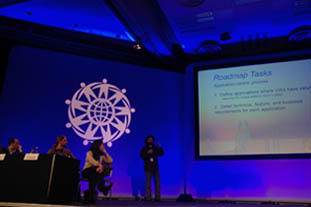
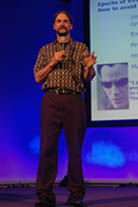
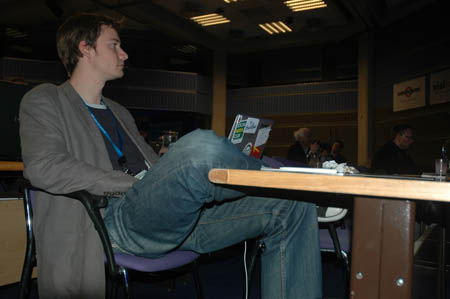
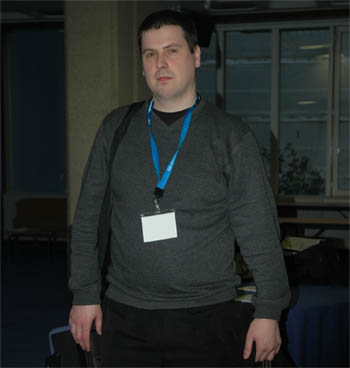


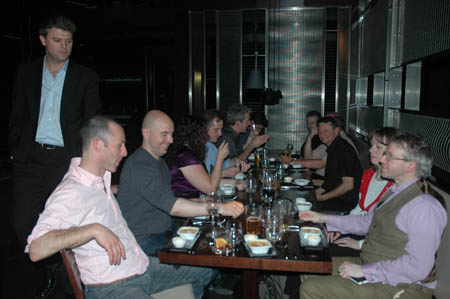
November 3rd, 2008 at 4:52 pm
enterprise vr – 3d worlds..
so bascially nothing new…;) lol
using Sibley’s recently found “history” of Virtual Worlds Past meme….
anyone here remember CA “Universe” ?
google. learn. then speak.
c3
November 4th, 2008 at 7:56 pm
I love the picture of Darren – very moody!